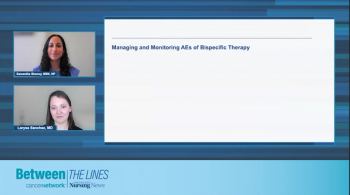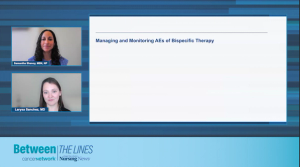Articles by Samantha Shenoy, NP, MSN

Panelists discuss how health care providers and patients should understand that talquetamab's unique adverse effects are temporary and resolve over time, even while continuing treatment, emphasizing the drug's excellent efficacy and the importance of removing stigma around its manageable toxicity profile.

Panelists discuss how effective caregivers should join support groups, maintain detailed records of symptoms and medications, attend all appointments, stay informed about myeloma research, and serve as active advocates who can communicate with health care teams when patients cannot.

Panelists discuss how patients beginning talquetamab treatment should maintain a positive attitude, prepare thoroughly with educational materials, and understand that although initial adverse effects can be challenging, they are temporary and manageable with proper preparation and support.

Panelists discuss how patients can maintain their nutrition during talquetamab treatment by focusing on texture and food presentation when taste is impaired, using high-calorie options, and remembering that taste changes and dry mouth are temporary adverse effects that improve over time.

Panelists discuss how specific talquetamab-related adverse effects such as skin peeling, nail changes, and rashes can be effectively managed through targeted interventions, including topical treatments, protective measures, and preventive strategies tailored to the drug's unique toxicity profile.

Panelists discuss how health care providers can develop comprehensive management protocols for talquetamab-related toxicities by consulting with specialists, gathering patient feedback, and creating detailed handouts that empower patients to proactively manage adverse effects before they begin treatment.

Panelists discuss how comprehensive patient education materials and manufacturer resources help patients prepare for and manage talquetamab adverse effects, with prior experience from chimeric antigen receptor (CAR) T-cell therapy providing valuable context for understanding potential complications such as cytokine release syndrome (CRS).

Panelists discuss how health care providers must actively educate local oncologists, emergency departments, and community centers about bispecific antibody management as these therapies move from inpatient to outpatient settings, ensuring proper recognition and treatment of adverse effects such as cytokine release syndrome (CRS).

Panelists discuss how successful talquetamab treatment requires coordinated care between inpatient and outpatient teams, comprehensive caregiver preparation including education materials and emergency contact information, and access to multidisciplinary health care providers as needed.

Panelists discuss how expectations for treatment outcomes can become more positive over time through experience with multiple therapies, staying informed about clinical trials and new treatments, and focusing on quality of life as a primary treatment goal alongside disease control.

Panelists discuss how caregivers can navigate the initial shock of a myeloma diagnosis by seeking reliable information from trusted medical websites, connecting with local support groups, and accessing resources from organizations such as the International Myeloma Foundation (IMF), Multiple Myeloma Research Foundation (MMRF), and patient advocacy groups.

Panelists discuss how Alan Plisskin's multiple myeloma diagnosis began with severe back and hip pain, progressed through life-threatening complications, including seizures and vocal cord paralysis, and revealed extensive lytic lesions throughout his body that required immediate intensive treatment.

Samatha Shenoy, NP, MSN, highlighted lifestyle recommendations to help patients who are receiving talquetamab treatment for multiple myeloma.

Clinical Scenario: AE Management for Bispecific Therapy in R/R MM
BySamantha Shenoy, NP, MSN,Beth Faiman, PhD, CNP,Ellen Marin, PA-C,Lisa Hwa, APRN, DNP, CNP, FAPO,Mary Steinbach, APRN Following the review of a case of a patient with relapsed/refractory multiple myeloma, the panel provides expert perspectives on adverse event management practices.

Samantha Shenoy, NP, MSN, discusses how her role plays a vital part in patient care for those receiving talquetamab for multiple myeloma.

Adverse Event Management Strategies in GPRC5D Therapy
BySamantha Shenoy, NP, MSN,Beth Faiman, PhD, CNP,Ellen Marin, PA-C,Lisa Hwa, APRN, DNP, CNP, FAPO,Mary Steinbach, APRN Experts on multiple myeloma address the intricacies of adverse event management practices, focusing on taste changes and associated weight loss.

Clinical Scenario: AE Management in a Patient with R/R MM on GPRC5D Therapy
BySamantha Shenoy, NP, MSN,Beth Faiman, PhD, CNP,Ellen Marin, PA-C,Lisa Hwa, APRN, DNP, CNP, FAPO,Mary Steinbach, APRN Samantha Shenoy, NP, MSN, presents the case of a patient with multiple myeloma and the panel discusses adverse event management practices.

Insights on REMS Programs and Strategies for Effective Patient Care
BySamantha Shenoy, NP, MSN,Beth Faiman, PhD, CNP,Ellen Marin, PA-C,Lisa Hwa, APRN, DNP, CNP, FAPO,Mary Steinbach, APRN The panel provides an overview of REMS programs for bispecific therapies in multiple myeloma and discusses how institutions can educate healthcare professionals outside of oncology.

Management and Supportive Care for CRS and ICANS in GPRC5D Therapy
BySamantha Shenoy, NP, MSN,Beth Faiman, PhD, CNP,Ellen Marin, PA-C,Lisa Hwa, APRN, DNP, CNP, FAPO,Mary Steinbach, APRN Experts on multiple myeloma discuss prophylactic supportive measures to prevent CRS and ICANS in patients who receive GPRC5D therapy.

Samantha Shenoy, NP, MSN, suggests that support groups may help comfort patients experiencing adverse effects negatively impacting quality of life.

Samantha Shenoy, NP, MSN, emphasized educating patients with multiple myeloma to help prepare them for potential taste alterations after talquetamab.

Samantha Shenoy, NP, MSN, indicated that neurological issues were not prevalent with talquetamab, despite occurrences with other bispecifics antibodies.

Clinical Experience in Managing AEs in GPRC5D Therapy
BySamantha Shenoy, NP, MSN,Beth Faiman, PhD, CNP,Ellen Marin, PA-C,Lisa Hwa, APRN, DNP, CNP, FAPO,Mary Steinbach, APRN Mary Steinbach, APRN, shares her experience in managing dysgeusia and nail- and skin-related toxicities seen in patients with multiple myeloma who receive talquetamab.

Clinical Perspective on AE Tolerance
BySamantha Shenoy, NP, MSN,Beth Faiman, PhD, CNP,Ellen Marin, PA-C,Lisa Hwa, APRN, DNP, CNP, FAPO,Mary Steinbach, APRN Focusing on patients with multiple myeloma who receive GPRC5D-targeted therapy, Beth Faiman, CNP, PhD, discusses how long-term treatment impacts patients’ tolerance to adverse events.

Samantha Shenoy, NP, MSN, discussed common oral and dermatologic adverse effects associated with talquetamab in patients with myeloma.

Experts provide advice for patients and caregivers with relapsed/refractory multiple myeloma considering talquetamab or another bispecific, while all faculty will discuss unmet needs and future perspectives in the treatment of relapsed/refractory multiple myeloma.

Experts discuss prophylactic measures for managing potential adverse events associated with talquetamab and other bispecifics, while all faculty will offer advice for health care providers involved in the care of patients receiving talquetamab.

Administration and Dosing Management
BySamantha Shenoy, NP, MSN,Beth Faiman, PhD, CNP,Ellen Marin, PA-C,Lisa Hwa, APRN, DNP, CNP, FAPO,Mary Steinbach, APRN Experts on multiple myeloma offer clinical insights on preparing patients who are going to receive GPRC5D therapy, highlighting step-up and treatment dosing for talquetamab.

Overview of Other GPRC5D Therapy Clinical Trials
BySamantha Shenoy, NP, MSN,Beth Faiman, PhD, CNP,Ellen Marin, PA-C,Lisa Hwa, APRN, DNP, CNP, FAPO,Mary Steinbach, APRN Beth Faiman, CNP, PhD, outlines unique toxicities seen with other GPRC5D-targeted therapies in multiple myeloma.

Experts provide advice to patients and caregivers on managing oral and skin toxicities.











